Text
Andy Warhol (Appreciation Post)
Crushed Cambell’s Soup Can (Beef Noodle) 1962
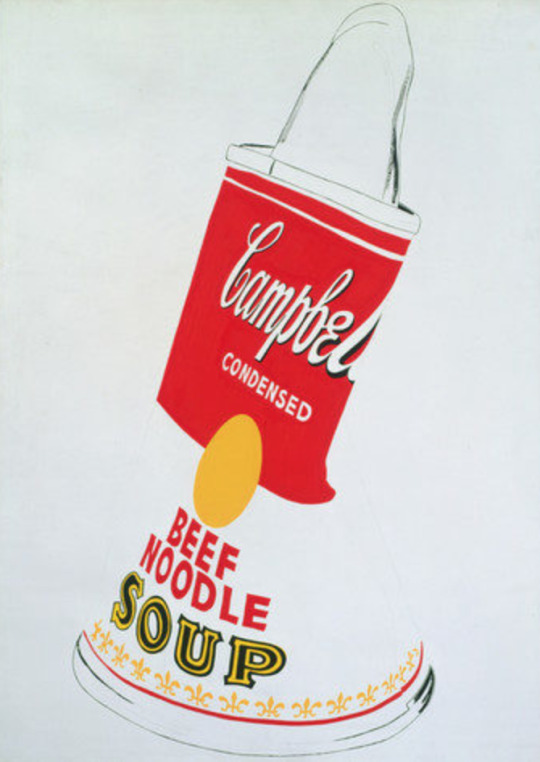
Jean-Michel Basquiat 1982
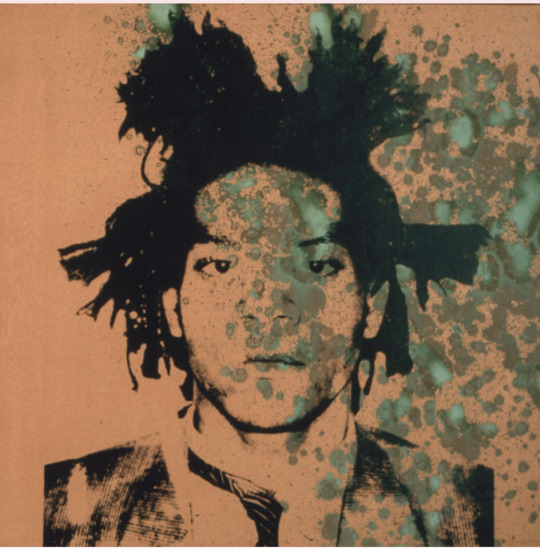
Flowers 1964
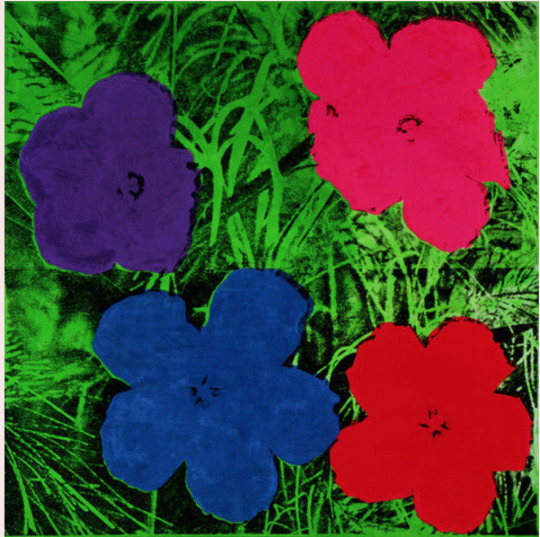
Do It Yourself (Sailboats) 1962
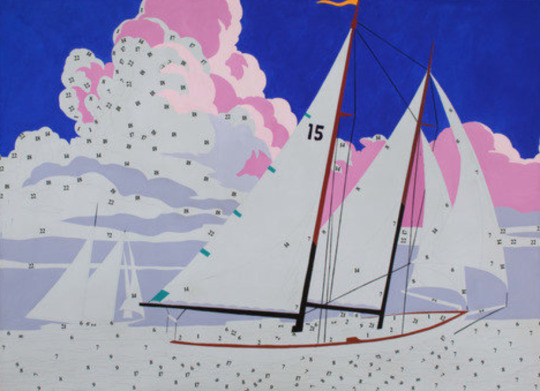
0 notes
Text
Murtaza Vali (Exhibit Organizer)

Murtaza Vali, a Brooklyn Based Curator, visited Cornell’s art students in an effort to educate us on the importance of abstraction being more than a “western creation” through the shows he has helped curate. He is a visiting instructor at the Pratt Institute and received his MA from NYU’s art program. Having also written for ArtAsiaPacific, Artforum.com, and Harper’s Bazaar Arabia Art- Valis also demonstrated the importance of having a background knowledge of art history and modern events.
Opening his talk, he gave a lengthy history of Abstraction in art history that is outside the western narrative with examples where abstraction is a tradition in other cultures (like in Islamic work). Abstraction is a formal pursuit, its uniqueness coming from its autonomy. Abstract works should stand on their own and not be read through the context of other works.
We know artists such as Jackson Pollock, the American cowboy artists who “pioneered” drip painting in the west and world. We know of Norman Lewis, who, in comparison to Pollock, was a marginalized artist even in his own community of African Americans who felt abstraction was not enough to convey the life of a black individual. We also know Donald Judd, Sol Lewitt, and Rasheed Araeen who participated in the Minimalist movement. But Murtaza Vali showed us that there are many artists we don’t know from our education such as Abdolreza Aminlari, Faycal Baghriche, and Kamrooz Aram. These artists’ works expanded our knowledge of what abstract and minimalistic art could be outside the western narrative.
Abdolreza Aminlari Situations (2012)

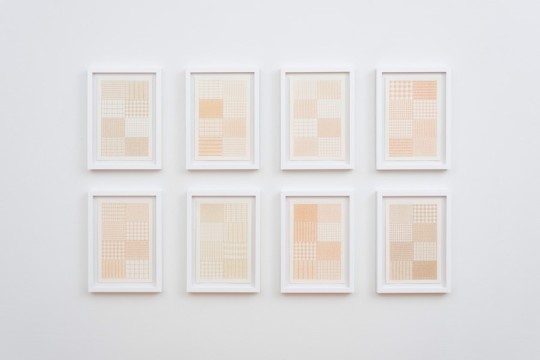
Faycal Baghriche Feiko (2012), Souvenir (2009)
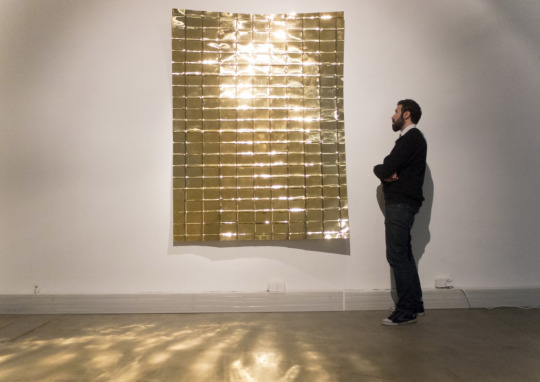
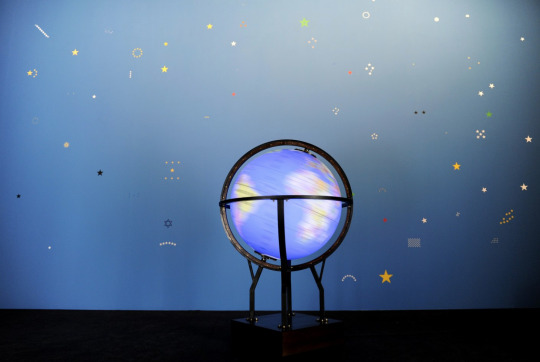
Kamrooz Aram Ornamental Composition for Social Spaces (2016)
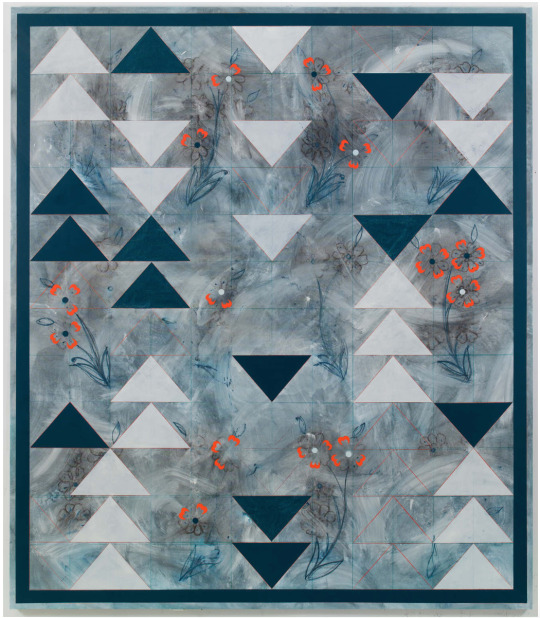
1 note
·
View note
Text
Hans Haacke: Art as a System
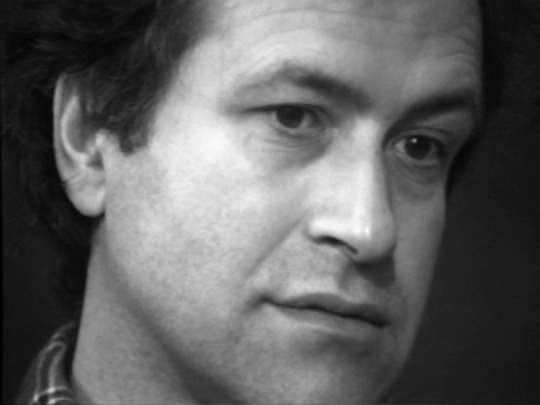
There is something deeply absent from the general education that Fine Art students generally receive in academia. Periods are defined by shifts in artistic style and technique (Classical to Baroque to Impressionism), the transformation of values are charted, and the star artists like Rembrandt and Picasso are championed. All these components that make up the study of art create an unnatural timeline of artistic expression that seems to exist separated from the influence of social and political histories. At best, works are a reflection of these histories but never interact within them. With this type of education, people are made blind to the power of art and the ways the art institution behaves accordingly to other systems. It is only by looking further into the artists relatively marginalized by general history that this problem begins to be rectified. One can start with an education of Hans Haacke, an artist who, through his diverse installations around the world, continues to critique power today.
HISTORY
In order to understand and appreciate the most recent works of Hans Haacke, it is critical to look at the beginning of his artistic practice and early life. Born in 1936 in the city of Cologne West Germany, Hans Haacke was a young boy through the duration of World War II. His parents were intellectuals of the Social Democratic party who refused to participate with the Nazi Party and as a result were marginalized. Haacke despite learning to be cautious regarding the ideas of his family, was encouraged to receive training in painting and graphics that would later lead to a masters degree from the Staatliche Hochschule für Bildende Künste in Kassel, Germany. After studying printmaking in Paris under Stanley Hayter and receiving a Fulbright scholarship in the United States Haacke began his first water installations in 1963. Unfortunately, these installations were not well received during the “Pop Art Era” in America so Haacke made the decision to move back to Cologne to continue his work.
CONDENSATION CUBE, BLUE SAIL
During the 1960s, the combined factors of museum directors pressured to exhibit conservative artwork along with the scarcity of rich collectors interested in young artists made it very difficult for Haacke to show his new kinetic works. To Haacke, kinetic art, with its literal use of motion, was what the times demanded. He refused to conform to the interests of the art market. This is the beginning of Hans Haacke’s long struggle with being an artist always on the edge of marginalization- very much like his childhood experiences during World War II. These water installations, and later wind, focused on the dichotomy between nature and machine. Specifically concerning his piece Condensation Cube (Figure 1. 1965), Haacke fused acrylic plexiglass into a cube requiring a technical precision that juxtaposed the semi-random activity inside the shape. The cube’s water would cyclically evaporate, condensate, and precipitate slowly before the viewer’s eyes. It was meant to be a display of the invisible mechanics of nature, a “re-evocation of what was always known about existence, but forgotten at one time or another” (Burnham 11). In an interview with Jack W. Burnham, an American writer, Haacke is asked to explain the relationship between machines and natural systems to which he replies, “Machines have a different temporal effect on human beings” (Burnham 17). By ���temporal effect,” Haacke means to differentiate the artificial time of machines to the rhythm of nature. The sunrise and sunset, tides, and moving of clouds are some examples of natural patterns of time that man’s breathing and heartbeat is in tune with. In contrast, the artificial timing experienced daily by machines are not in sync with our nervous system. With this explanation, it is easy to see how the integration of natural systems within machines like in Condensation Cube or Blue Sail (Figure 2. 1964) can actually offer a solution to an ill, technologically advanced world.
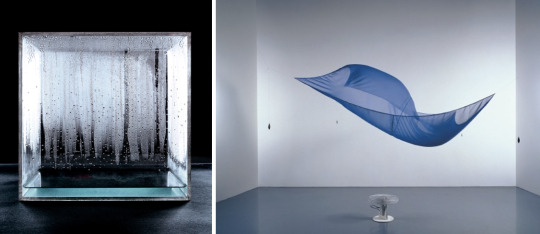
GENERAL SYSTEMS THEORY
More importantly, Haacke’s main intent with the creation of these kinetic sculpture’s was to explore the ideas of General Systems Theory and “real-time” that had just been theorized by Austrian biologist Ludwig von Bertalanffy and UK economist Kenneth Boulding in 1955 ten years later. General Systems theory is composed of determinants: elements outside the system which determine the nature, form, and limits, components: moving parts, mechanisms, and men within the system, and system integrators: elements that integrate moving parts, operating sequences, and communications. In all, the theory is a focus on system responses to the environment. Ahead of his time, Haacke recognized, and demonstrated quite literally with his kinetic structures, that art pieces are systems which do not go unaffected by the viewer, market, or political atmosphere. In addition, inspired by the United States Airforce’s development of computer system networks working in “real time” to show missile deployment, the German artist understood that if his art was to be a system it must also be connected in “real-time.” These ideas are revolutionary in comparison to how traditional artwork exists in “mythical time” separated, in Haacke’s words, from the “day to day events of the world” (Haacke 130). Which also means that any public or official responses to his work, or any variations that the work may take, is part of the piece itself. In this way, Hans Haacke fully separates himself from the Formalist movement, which emphasizes form alone, and begins a career focused on creating work engaged with the environment.
PERIOD OF DISILLUSIONMENT
From World War II and onward, as the years past in the artist’s life, the world remained restless. After his kinetic sculpture phase, three main events shaped Haacke’s attitude on his role going forward in society; the continuation of the Vietnam War from 1955 to 1975, the French protests against colonial policies in Algeria in 1961, and the assassination of Martin Luther King in 1968. (Haacke 129) The Vietnam War filled Haacke with disillusionment and frustration as international protests went ignored and activist efforts thwarted. He witnessed the same phenomenon in Paris where police violently fought against students, leftists, and intellectuals who marched against colonialism. But the tipping point for Haacke was the murder of MLK wherein a letter he writes,
Whoever believes that art can make life more humane is utterly naive… Not a single napalm bomb will not be dropped by all the shows of ‘Angry arts.’ As I’ve said, I’ve known that for a number of years and I was never really bothered by it. All of a sudden it bugs me. I am asking myself, why the hell am I working in this field at all…. I still have no answer, but I am no longer comfortable. (Haacke 130)
An artist who denounces art is usually unheard of and so, this letter realistically depicts Haacke as an individual angered by his powerlessness (a feeling many have but do not express). To many art historians and critics, this event serves as the turning point in Hans Haacke’s transformation into a political activist; the evidence being his new membership with the NYC Art Workers Coalition from 1969 to 1972. Gradually, moving between the United States and Germany, Haacke began to explore the now contemporary art themes concerning economics and the art market, social and cultural power, and political history. Many historians characterize his work in the ’60s as being focused with “systems” while his ’70s work is concerned with political conceptual art. It is appropriate to assume that Hans Haacke himself would disagree with this generalization. For his interest with systems and politics are essentially the same at the core. Going back to General Systems theory, political and artistic institutions or “systems” interact with one another; a connection purposely censored by the individuals who wield power in both. Thus, Haacke sought to create “real-time systems” not outside the “zone of art” but outside the oppressive and dubious practices characteristic of galleries and museums (Fleck 26).
POLLS
Hans Haacke's polling pieces and questionnaires in the Jewish Museum’s Software exhibition, MOMA, and Wise Gallery serve as his first attacks on the art industry. To make Gallery-Goers’ Birthplace and Residence Profile, Part 1 (Figure 3. 1969), Haacke hung up maps of Manhattan on the walls of the Howard Wise Gallery and asked visitors to put a red pin for their birthplace and a blue pin for their place of residence. As more visitors entered the gallery, the accumulation of pins visually exposed the demographic with the greatest presence in the artistic space. These particular people, in turn, have the greatest influence on what is shown and censored in the gallery with the power of their dollar. Using multiple choice in the Jewish Museum, Haacke had viewers answer demographic and sociopolitical questions generated by a computer. Example questions being, “In your opinion is the moral fabric of this country strengthened or weakened by the US involvement in Indochina?” (Richter 64) to which visitors would then get a real-time print out of the processed answers. At the 1970 MOMA exhibit, the artist went a step further by color-coding ballots based on the visitor’s status whether they were full paying, a holder of a courtesy pass, a visitor on Monday when admission is free, or member of the museum. The transparent ballot boxes then revealed demographic opinion in the context of their socioeconomic status. Within all these pieces is a critique of the belief that a museum serves universal interests. Hans Haacke cleverly exposes the concealed economic structure behind the art institution by having the polls address the audience as members of social groups influenced by history and status instead of private beings. Another layer of the work is that the polls, used as tools of representative democracy, shows the lack of representation in museum crowds. According to editor Robert Fleck of the catalog Hans Haacke For Real, the polls were an “attempt to produce a self-portrait of the art public and create awareness” (Fleck 71). With this self-portrait, it is clear that access to the art institution is socially determined instead of a universal right. Which begs the question- who, along with the audience, controls the dialogue within the gallery? Hans Haacke’s “direct address” of the public was the first step in bringing down art from the heavens and exposing it for what is it- a sometimes fraudulent organization peddling toxic brainwash from corporate and political powers. As someone who experienced the fascism of the National Socialist German Workers’ Party, Hans Haacke has a heightened awareness of anti-democratic practices within democracies.
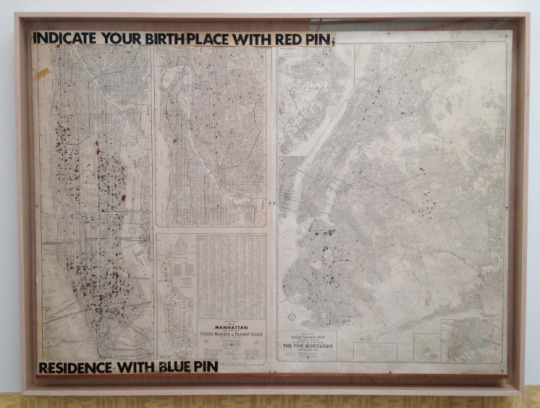
Manet-PROJEKT ’74
Consequently, it was these pieces that moved the Guggenheim to cancel his solo exhibition and be uninvited from Documenta 6. Initially moved by self-defense, this censorship pushed Hans Haacke to be more aggressive in his persistence exposing art’s role in society. What he found over several years is that social and political influence on the perception of art is much greater than we think or admit. In fact, many who claim they are “art supporters” consistently threaten the autonomy of art. The best example of an “art supporter” in this context is Hermann Josef Abs, a German Banker, and his relation to Hans Haacke’s work Manet-PROJEKT ’74 (Figure 4. 1974). The piece gave a timeline of ownership for Édouard Manet’s painting Le Botte d’Asperges using information on public record. Haacke gave a complete history of the painting's owners all the way to the museum trustee board that currently possessed it. What was unusual about this work is that it publicized data usually dismissed by museum-goers or hidden intentionally by the art institution. One figure that desired to remain anonymous was Josef-Abs, an affluent banker and patron of the arts. Reason being his central role in economically stabilizing the (Nazi) National Socialist party and its war economy through forced labor in concentration camps. This history is incredibly important considering all the past owners of the painting before Abs were Jewish. The effect of creating this timeline demonstrates how art exists within history as a system that participants in events instead of just being a depiction of events. In addition, Manet-PROJEKT ’74 shows the unfair acquisition of Jewish wealth by the Nazis. After pressure from the director of the Wallraf-Richartz-Museum and Abs, Haacke’s work was removed even though the information about Abs’ life was public record. In response, Daniel Buren, a French conceptual artist, photocopied Manet-PROJEKT ’74 and pasted it onto his work in the exhibit as a protest against the museum's censorship. Again, Haacke’s message concerning the corruption of politics and art is strengthened through the very actions of the corrupt institution itself. The same can be said with later works such as Der Pralinenmeister (1981) and Oegelmaelde: Hommage à Marcel Broodthaers (1982). In his progressing career, Haacke continued to experience the censorship of his work and was almost marginalized into obscurity.
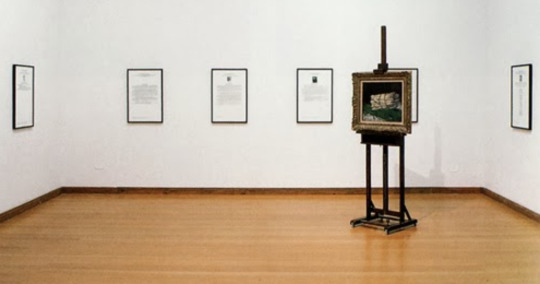
GERMANIA
Uninvited to multiple Documentas and heavily criticized by the industry, Hans Haacke essentially sacrificed the acclaim and wealth he could’ve had by pursuing unpopular political ideas. Unlike his contemporaries Andy Warhol and Jeff Koons who only provided shocking aesthetics and did little to forward democracy, Haacke was uncompromised as he battled with art and power. His two biggest battles being the installation of GERMANIA in 1993 (Figure 5) and DER BEVOLKERUNG (Figure 6) in 2000 as systems interacting with the historic and current political attitudes of Germany. Invited, surprisingly, by Jan Hoet to the Documenta 9 Hans was given the task to fill the German Pavilion redesigned by the National Socialists in 1938. So in response, Haacke disrupts the art scene with an entirely new way of thinking about sculpture. Using methods of removal and addition, he destroys the floor of the Pavilion into slabs of broken concrete and dust. “Germania” is then written above the rubble and where there was once a Swastika in the building is a Deutsche Mark. The work’s most important aspect is not it’s use of materials but the use of historic information in its creation. The building’s foundation, destroyed by Haacke, is a metaphor for the destroyed foundational ideologies of the past Socialist Party. However, the piece is more a critique of the, then, recently reunified Germany. With reunification, people accepted the illusion of a new modern nation. Hans Haacke’s response to this belief is that the “new” Germany is essentially built from the frame of the old Nazi regime. The Deutsche Mark being in the place of the Swastika communicates that Capitalism, although posing as “rebirth” for the nation, is, in reality, the same Fascism. These criticisms are extremely powerful and display the extent of Haacke’s political awareness. Like his past pieces, the work exists in real-time as viewers step over the rubble, creating dust clouds and shifts. Viewers are put in the position as participators to demonstrate that they are, as well, participators in history. It is this work, requiring participation, that places Hans Haacke as part of the Post-Minimalism movement of “event art.”
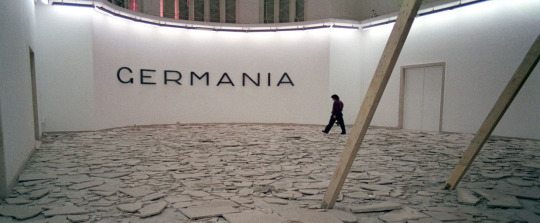
DER BEVÖLKERUNG
Continuing, DER BEVÖLKERUNG was another political criticism against Germany’s contemporary, delusional attitudes. More relevant to the issues of Germany today in 2018, the piece examines Xenophobia. Once encouraged to immigrate into Germany by programs designed to stimulate the economy, Southern Europeans and Turks are now being pressured out. The discrimination that these people currently experience is very similar to the beginnings of what eventually turned into the Holocaust. In response to these dangerous attitudes, Haacke juxtaposes, using the same lettering, the words “Dem Deutschen Volke” (to the German people) written on the Reichstag Parliament with “Der Bevölkerung” (the population). To Haacke, “Dem Deutschen Volke” reinforces xenophobia by essentially reserving the parliament and its representatives for the German people which, in effect, excludes immigrants. To Germany, this artwork misappropriates one of the most sacred symbols of the nation. Only approved by a small minority, the work continues to be in the garden courtyards of the Reichstag. And as a system, the uninterrupted growth of weeds around the work parallels a message warning against the attitude of seeing immigrants as undesirables (rooting them out like weeds). DER BEVÖLKERUNG, a piece rooted into the ground, is another example of how art to Haacke needs to function as a system that interacts with the public in a dialogue concerning political and social issues.
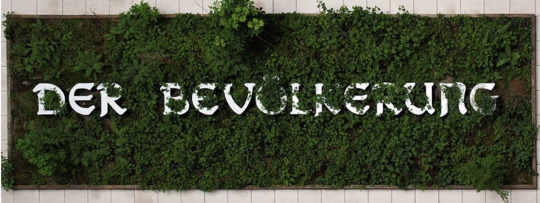
PRESENT INFLUENCE
Looking back from 2018, Hans Haacke has provided four decades of artistic activism that remains unparalleled by any other artist; his relevancy is stronger than ever as we enter an age of “fake news” and capitalistic totalitarianism. Western Civilization can be characterized as being compiled of “protected democracies” where Democracy is suspended in the name of protecting Democracy. This is evident in pursuit of terrorism by the United States after 9/11. Therefore, these new political systems require us to reexamine the art institution and its values. This new age asks us to question how the two institutions work together to influence public opinion. Who are the marginalized artists of today that resemble Hans Haacke and what information is being censored? It is not only his singular works that maybe provide possible answers but the experiences surrounding the works: ones involving censorship and corruption. In this way, Hans Haacke perfectly fulfills the needs of the contemporary age.
0 notes
Text
Distracted by Technological Spectacle (Experience at Whitney)
The Whitney’s new exhibit Programmed: Rules, Codes, and Choreographies in Art, 1965–2018 was a fascinating spectacle meant to educate visitors on the mechanisms behind the age of computers we now live in. With a multitude of pieces focused on visualizing code and function, the exhibit was an exciting circus. However, many people weren’t interested in understanding the pieces as they were interested in the coolness of the exhibit. This phenomenon was actually terrifying and upsetting to witness. As technology continues to rapidly improve and self-improve with artificially intelligent programs, it feels as though the general public will never understand the inner mechanisms that now control their surroundings, And if they can’t understand even that, what will push them to understand the effects of technology as well?
Augmented Reality by Tamiko Thiel demonstrated this relationship between people and technology perfectly. Augmented reality is the technological overlay of virtual elements onto physical reality to create a new dimension. With two ipads open to visitor use, people could overlay a world of plastic refuse and coral-like formations over the museum floor. As each visitor used the ipads, the corals react by dying off slowly. The piece is supposed to represent the overwhelmingly negative impact humans have on the environment. The piece was meant to scare us of a future that is very real- one where a warming atmosphere causes ocean levels to rise because of increased CO2 levels. Instead of understanding this, or even reading the piece description given by curators, visitors treated the work as pure entertainment. Then, they would walk happily away because they have a new cool Instagram post.
This shows very clearly how the way the general public uses technology is just as an entertaining distraction that overloads our senses and makes us numb to reality. Augmented Reality should have woken people up, instead, it further sedated them. Despite efforts made by artist and programmers take to educate the public, the way that technology is used is out of their hands. We may be a hopeless species.
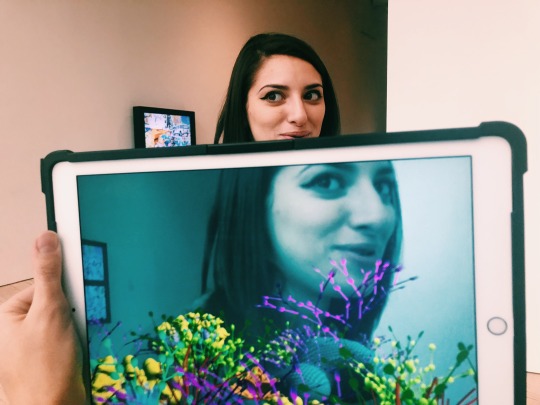

0 notes
Text
W. Bradford Paley (NYC TRIP)
Yesterday, Cornell University arranged for its art students to visit the MOMA PS1 and Whitney Museum in Long Island City and Manhatten. Our trip to PS1 MOMA was intended to teach us that there is more to just the “art making” part of museums. Behind each piece, installation, and performance is an exhibit organizer and curator who work in conjunction to arrange how the art is viewed; which is just as important as the artist who creates the pieces.
Afterward, we traveled to the Whitney where two new exhibits were opened: Andy Warhol - FROM A TO B AND BACK AGAIN and PROGRAMMED: RULES, CODES, AND CHOREOGRAPHIES IN ART, 1965-2018. I absolutely loved the PROGRAMMED exhibition. The name comes from the fact that the exhibit was focused on programmed art by computer code. From the Whitney Museum’s website:
“The exhibition links two strands of artistic exploration: the first examines the program as instructions, rules, and algorithms with a focus on conceptual art practices and their emphasis on ideas as the driving force behind the art; the second strand engages with the use of instructions and algorithms to manipulate the TV program, its apparatus, and signals or image sequences.”
As someone who participated in my high school's robotics team and has an interest in computer science such as Python and C++, I have always dreamed of such an exhibit. They are rare and I am happy museums are finally recognizing how technology is, directly and indirectly, influencing the creation of art.
An artist I was particularly interested in was W. Bradford Paley. As an associate professor at Columbia University, he studied computer graphics at UC Berkeley in 1981 and founded Digital Image Design Incorporated. His work and art practices focus primarily on making complex code and date easier to understand by those who are not familiar with CS. He does this by making visual displays that actively engage the viewer. This new form of digital art can be seen as a form of abstraction for someone who doesn’t understand- a commentary on how the population is emersed in a digital world they know nothing about.
A piece of his that interested me was CodeProfiles, Java Program. CodeProfiles looks at the computer program as text and visually comments on how code is ready by people, written by programmers, and executed by computers. Reflecting on its own construction, the work consists of the code that makes the code visible on the screen. Paley makes three points visible with an amber, white, and green line.
Amber line: follows the fixation point (tracing how people might read the text)
White line: follows the insertion point (flows like programmers thoughts)
Green line: moves along the execution point (creating swarths where the code was executed)
By doing this, Paley visualizes the program that runs behind most digital art- driven by a language formulating instructions.


I plan on revisiting this exhibit with my family so they can also enjoy the new wave of digital art.
Thank you Cornell,
0 notes
Photo
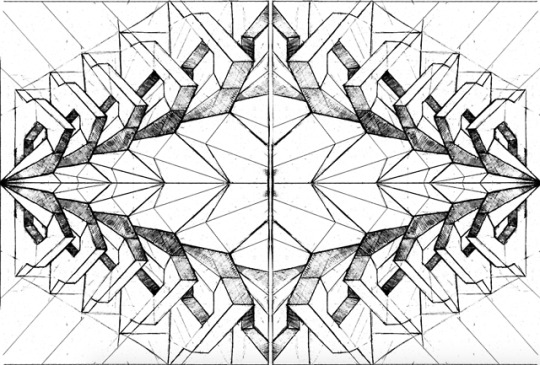
Blueprint drawing for my intaglio print. This is reminiscent of the early computer art made in the 60s and 70s focused on geometry and form.
“This was, in part, due to the restrictive nature of the available output devices, for example, pen plotter drawings tended to be linear, with shading only possible through cross-hatching.”
Will need to be etched with ferric acid and then aquatinted. Updates on final print coming soon.
0 notes
Photo
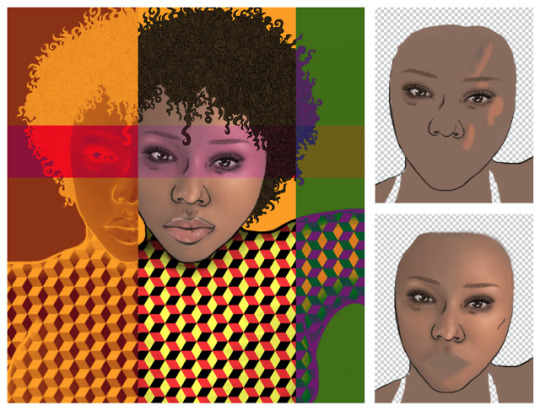
A throwback to when I taught myself how to do digital portraits in photoshop. I feel it is really important to go beyond what is instructed in art class and search on youtube for tutorials that help advance outside interests. Every medium learned helps the entirety of my artist practice.
0 notes
Text
Stanley William Hayer
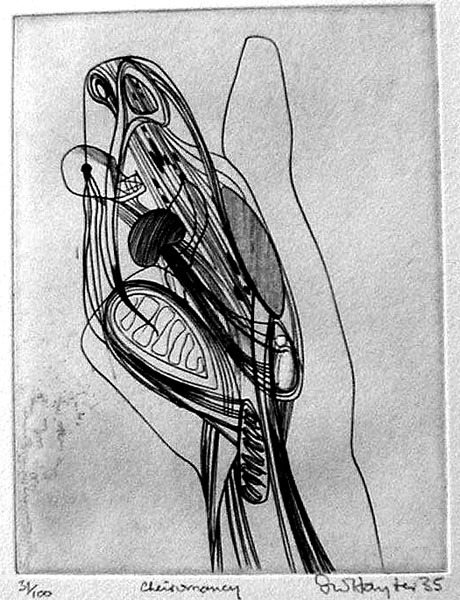
Cheiromancy (etching, engraving) 1935

Combat (etching, aquatint) 1953
Hayter is one of the key figures of the Surrealist movement both for his contributions as a printmaker and for his technical wizardry. Founder of Atelier 17, probably the most important print workshop of the middle third of the century, he worked with Chagall, Ernst, Giacometti, Lipchitz, and Miro. His early training as a chemist led him to one of the most important printing innovations of the 20th century, color viscosity printing, which allowed the use of multiple colors of different viscosity oil bases to be printed in the same pass through the press, and facilitating the growth in color etching between and after the World Wars.
0 notes
Text
Identity Politics
youtube
This video is the medicine our seminar class needed. I absolutely love our mature class discussions and assigned readings. However, the content and narrative of those discussions and readings have yet to change. The past couple of weeks have become this closed loop, an echo chamber of identity politics, especially after our readings on intersectionality. Though we could continue to discuss black and female identities, this perspective is quite narrow and one dimensional. There is so much more than that. Like the video said, by focusing so much on what makes us different we’ve lost sight of what makes us the same. And I fully understand the discussion of historic and current marginalized groups is important in order to create equality, the therapy sessions of the class are usually not constructive.
On a side note, why is this video an “Age-Restricted” video based on “community guidelines.” I have seen videos on youtube with extremely violent and pornographic content that in no way educates but is open to all viewers. Why is access to this extremely important clip restricted then? It speaks of having an understanding of one another for social and political progression. Does this video undermine the institutions in power that want to keep the public fragmented and distracted so that they cannot see the real problems of society? Just a thought...
0 notes
Text
Jackson Polys
Today, the students of AAP were given the opportunity to be educated on the works of Jackson Polys by the artist himself. He is an artist who identifies as being part of the indigenous group called the “Tlingit” of the Pacific Northwest and bases his practice in both Alaska and New York. Nathan Jackson, an artist and the father of Jackson, taught him as a young child how to carve wood. Consequently, since the age of ten Jackson has been able to make incredible totem poles and installations. His artistic upbringing along with Tlingit exposure encouraged Jackon to have an artist in indigenous identities and possible growth. With a BA in art history and visual arts and an MFA in visual arts from Columbia University, it was possible for Jackson to open many gallery shows, museum exhibits, and participate in events such as the Sundance Film Festival.
Jackson Polys began his lecture at Cornell University with ideas concerning Manifest Destiny, the occupation of space, propriety, lineage, and legitimacy. All concepts related to the displacement of indigenous groups by unjust political powers and the modern movements to retake space. However, Jackson also says there is a “privilege of naming, claiming lineage as proprietary, claiming a space. What is the legitimacy of claiming a space- land, sea, air?” By asking this questions towards indigenous tribes one also asks the questions to those pioneers of manifest destiny that originally stole land. In relationship to Cornell, we begin every lecture recognizing the fact that the university sits on what was previously sacred Indian land. That recognition is important, but is it enough? Can we rectify those who have been wronged solely with recognition? Jackson then says, “Keep open minds of sustained inquiry.” So I guess this line of questioning is warranted from his lecture.
Continuing he discusses the process and the materials used in his pieces. At the beginning of his artist career, he’d stick to neoclassical perfection/ technique of wood carving when making these Tlingit structures. Slowly, Jackson came to the realization that this neoclassicism realism didn’t allow him to create freely and expanded his range. The artist began a heavy use of digital media, plastic, foam, gel, bright colored paints, etc.
Slowly, the new medium gave him a new mindset in his work. The new medium challenged Jackson to think of what being indigenous is in a contemporary society. One example being is carved totem animals that he paints in bright colors that are untraditional to the art form. Another example is his carving of an animal that is not Tlingit. Is it a celebration or is it destruction? Or can the piece be a celebration and destruction of the culture at the same time? Is that even possible? During the lecture, Jackson demonstrated that questions were sometimes more important than their possible answers.
The main take away that Jackson Polys left his audience with is “does indigenous have to mean something prior and primitive?” Or can the indigenous be contemporary? What about the indigenous artist and their work? It is clear that Jackson Polys views himself as an informant of society with the goal of making the indigenous part of the modern world, taking them out of their seclusion.

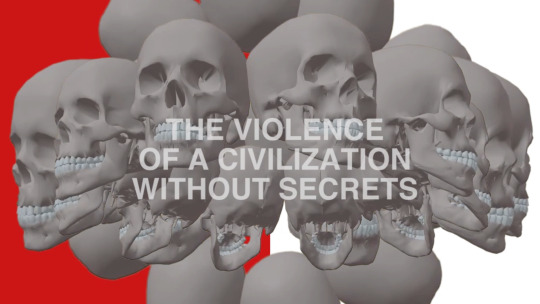

0 notes
Photo

I originally started this work as a realistic digital portrait of my friend Ariel Harisnay with the intention of exploring a new medium and improving my skill for realistic portraiture. Instead, I found it more fun to explore the different tools of photoshop (filter, distort, saturation levels) and create a surrealistic portrait. I also broke down the layers of the photoshop file to display the process of “building” required in this art. For the future of this work, I plan to turn it into a physical print. This piece is my effort to communicate my disliking of the modern portrait or selfie in the digital age used to show only the narrative of beauty. I find the distorted face to be beautiful as well.
0 notes
Text
Demystifying Data: Rap Lab
The Rap Research Lab is a place for teaching art, design, data analysis, and data visualization to students using a project-based curriculum that visualizes hip-hop as a cultural indicator. Students learn principles like Syntax and Semantics when looking at artists like Kanye West and Biggie Smalls. The syntax of a rap song is the word count, reading level, rhyme density, and perfect rhymes. Semantics include sentiment, keywords, people, and places. One project example is by Tahir Hemphill himself where he took the location data of twelve rappers and from their first song to their last song (the places they rapped about), sent the coordinates to a robot arm that then traced them. The end result was later even made into a sculpture. This visualization of data is much more understandable than a spreadsheet. So what this program does it make 1. data more understandable 2. teach kids about data in a familiar, interesting way they can comprehend.
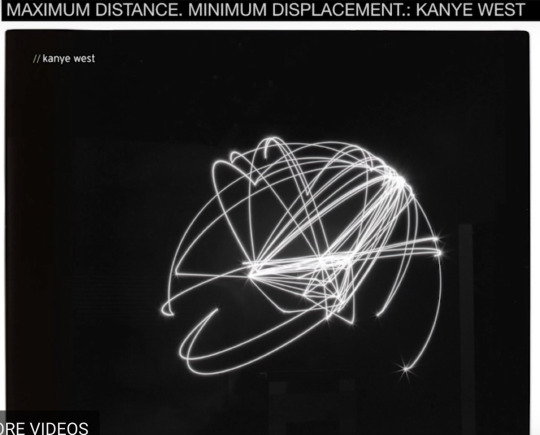
I once did the same thing myself. I worked in a bioinformatics lab that was concerned with visualizing and analyzing genetic data. But genetic data by nature is very difficult to understand with its T’s A’s C’s G’s. So it was my job to organize this information regarding the correlation between bacteroids and Firmicutes (two gut flora microorganisms) with obesity in patients. In the end, the graph I made looked like contemporary art so I translated it into an installation. Below is the end result:

0 notes
Text
Beverly Semmes
With the fashion industry heavily centered on the female as the target buyer, we are used to seeing images (advertisements) showing women (models) in clothing. In these conditions, Beverly Semmes is a refresher; showing the relationship between clothing and women with the absence of the later that speak towards feminism and power. Many of her pieces take clothing and make it sculpture. These oversized and dysfunctional pieces of clothing take up huge gallery spaces. One of her more known pieces “Blue Gowns” is gigantic in scale, towering over ten feet. In an interview with Artforum, she speaks about how her sculptures should be so big they push the viewer to the side, it doesn’t let them in the room.
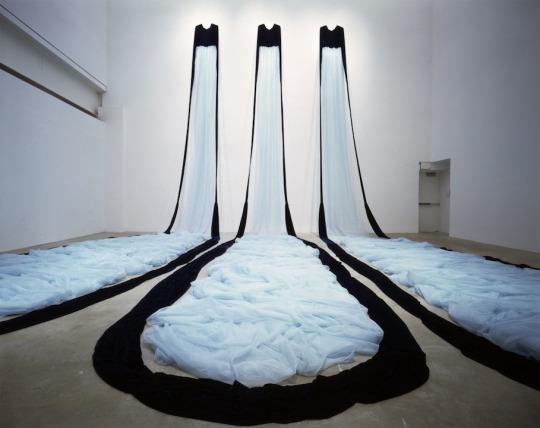
Not many artists create pieces that don’t allow their viewer into the gallery space. It can be interpreted that the pieces act defensively, as do the women who would wear the clothing or the ideas of feminism which are constantly attacked.
Another piece, “Buried Treasure”- crushed black velvet sprawled around the galleries entire floor connected to a dress sleeve- works to defend the female. But the body is consistently absent from the works as Semmes finds more interest in the fabric that does/ or does not cover the body.

But Beverly Semmes works beyond the constraints of fabric in her ceramic sculptures and prints. Her “Feminist Responsibility Project,” is a collection of pornographic images of women that Beverly had censored with paint and collage. She feels by “editing�� these pornographic images where women are objectified and their bodies commodified, she regains power while simultaneously creating humor.

Unfortunately, her ceramics have yet to be fully explained by her in interviews or by sites that have written of her. However, during our Cornell lecture, Semmes explained that,
“As women, we are always told to be thinner and do also be more… these pots explore that.”
These posts explore this toxic dichotomy. I think it is because a ceramic pot is associated with the female and to have these deformed pots is another commentary on the female figure.
Semmes leaves us with the final question,
“Can space be a metaphor for power?”
0 notes
Text
Suzanne Lacy’s Between the Door and the Street.
“You know it’s not every day when we shut down our city blocks for things other than tube socks and Italian sausages; so to something that really has a profound transformation on our individual lives and our collective lives- I think is very exciting to people.”
- Anne Pasternak, President & Artistic Director, Creative Time. (4:01)
The video begins with the hustling of people organizing and collaborating in a huge event not explicit to the viewer in the first few minutes. We are left to assume what is happening: “maybe this is theatrical play, flash mob, or protest. Or maybe all three at once.” The same canary yellow tape that lines the borders of the streets also is wrapped around the heads and necks of these women in the clip. It is halfway through the video when Suzanne Lacy reveals the connection between the street and all these females she had gathered. They are all participating in a symbolic gesture demonstrating the power, and hence the importance, of having women dialogue about women’s issues in public spaces. Women are shown talking about being a sister, their love life, relationship with their fathers, domestic violence, aging, etc.
“What is something you want for your daughter’s education.”
“Talk to me like I’m your daughter, your sister, or your mother... don’t talk to me like I’m your next meal.”
“No daddy I’m queer and I embrace both genders.”
People walking through the public performance piece would listen to these diverse groups of women in age, race, socioeconomic status, etc and then start a dialogue outside the yellow line. It served as a wonderful example of what female unity could be.
I absolutely loved the work of Suzanne. As a focuser of “social themes and urban issues,” I respect a lot of her artistic efforts. Suzanne in this way is truly an artist-citizen. Particularly with this piece, “Between the Door and the Street” I found it a hopeful shift in society’s focus. How the streets, reserved for the auto industry and vendors, can also be used for social and politically charged dialogue. And when we begin to have that on the streets, it demonstrates that we as a society are capable of valuing important discussion over street meat.
youtube
0 notes
Text
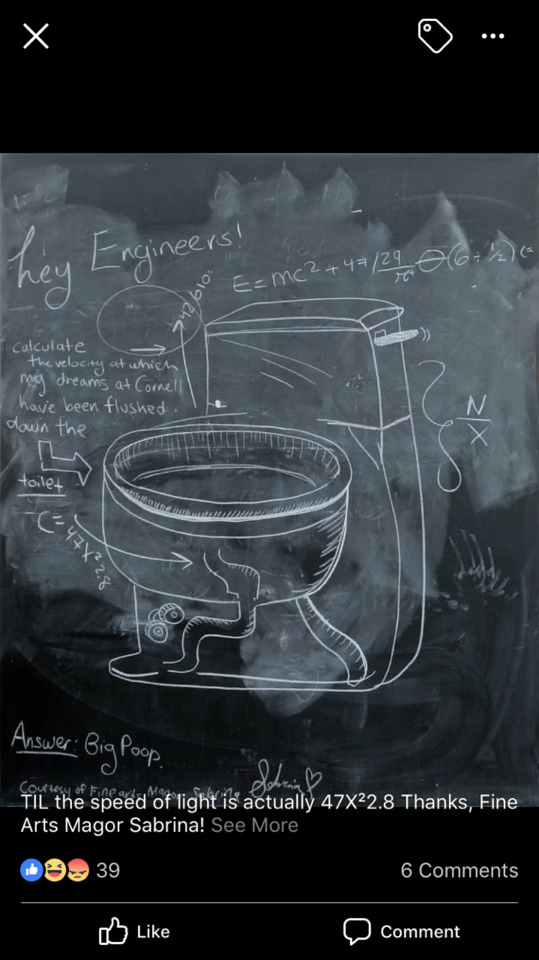
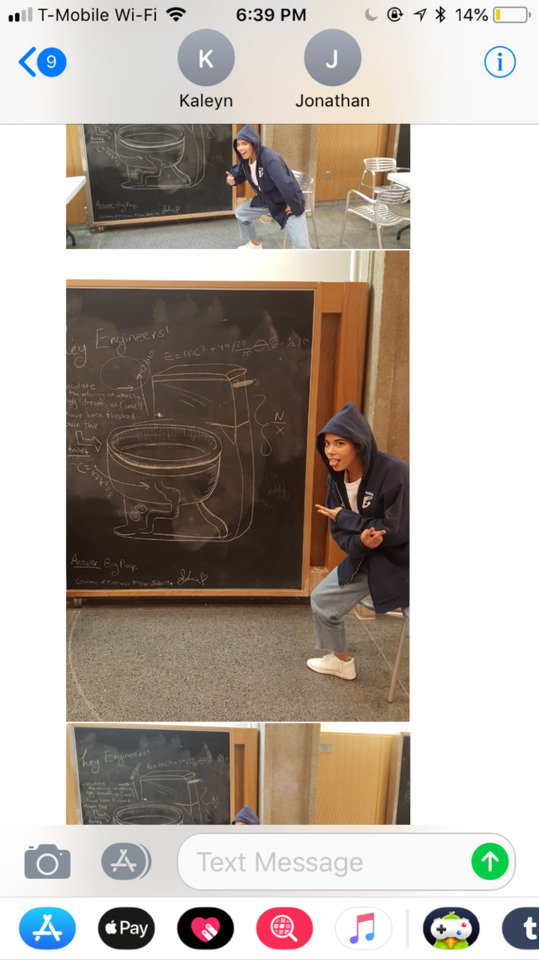
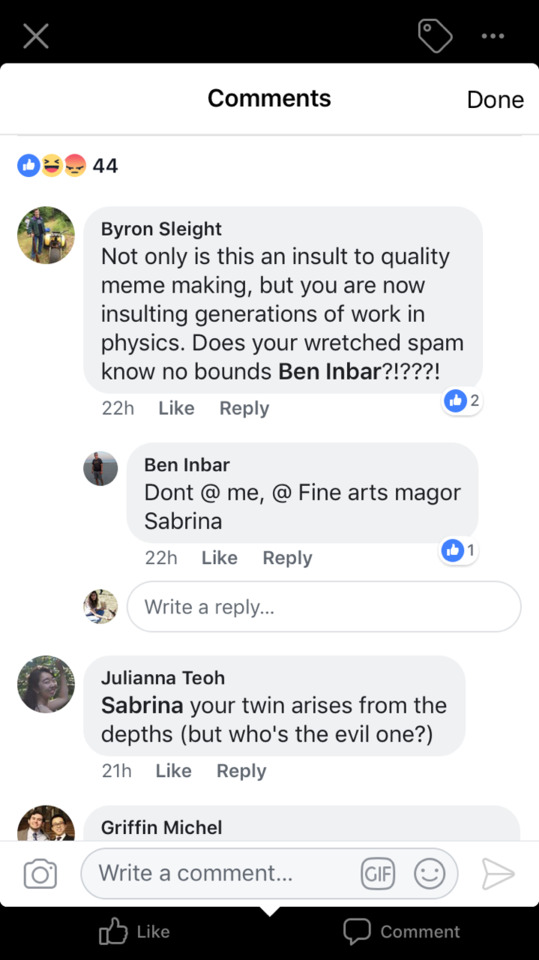
3 am spontaneous art piece created in the Physical Sciences Building. The intention was to disrupt the logical equations so common to these chalkboards by placing nonsensical mathematics and drawing in the space. Many people got enjoyment from the piece even though it was a joke. It was fun to claim the territory as an artist in the engineering space.
0 notes
Text
Romare Bearden, 1964: Collage as KUNSTWOLLEN!

The Train, completed in 1975.

Jamming at the Savoy, completed in 1981.

Quilting Time, completed in 1979.
0 notes
